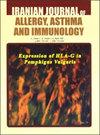长链非编码RNA-MALAT1和白细胞介素-6在炎症性肠病患者中的表达分析
IF 1.2
4区 医学
Q4 ALLERGY
Iranian journal of allergy, asthma, and immunology
Pub Date : 2023-11-07
DOI:10.18502/ijaai.v22i5.13997
引用次数: 0
摘要
炎症性肠病(IBD)表现为胃肠道的慢性炎症。这项研究的重点是一种名为转移相关肺腺癌转录本1 (MALAT1)的长链非编码RNA (lncRNA)。MALAT1的失调与多种自身免疫性疾病有关,并调节促炎细胞因子。il - 6在包括IBD在内的免疫触发性疾病中的作用是另一个焦点。本研究仔细分析了IBD患者中MALAT1和IL6的表达,以揭示潜在的相互作用。 该研究涉及33名IBD患者(13名患有克罗恩病,20名患有溃疡性结肠炎)和20名健康对照者。实时定量聚合酶链反应测定MALAT1和IL6基因表达水平。利用LncRRIsearch和Cytoscape等工具构建了竞争性内源性RNA (ceRNA)调控网络。深入研究炎症性肠病数据库以了解il - 6在IBD中的作用。潜在靶向这些基因的药物也通过ddgidb被确定。结果显示,与健康对照组相比,IBD患者的MALAT1和IL6表达水平显著升高。MALAT1与IL6没有直接的线性相关,但IL6 可以作为MALAT1的目标。分析揭示了MALAT1和IL6之间的相互作用,由hsa-miR-202-3p、hsa-miR-1-3p和has-miR-9-5p调节。IL6在ibd相关炎症中的关键作用,可能与其他细胞因子相互作用,被强调。此外,还发现了治疗MALAT1的CILOBRADINE和治疗IL6的SILTUXIMAB等潜在药物。 本研究强调了MALAT1和IL6作为IBD患者诊断和治疗靶点的潜在价值。本文章由计算机程序翻译,如有差异,请以英文原文为准。
Expression Analysis of Long Noncoding RNA-MALAT1 and Interleukin-6 in Inflammatory Bowel Disease Patients
Inflammatory bowel disease (IBD) manifests as chronic inflammation within the gastrointestinal tract. The study focuses on a long noncoding RNA (lncRNA) known as Metastasis-associated lung adenocarcinoma transcript 1 (MALAT1). MALAT1's misregulation has been linked with various autoimmune diseases and regulates proinflammatory cytokines. The role of IL6 in immune-triggered conditions, including IBD, is another focal point. In this research, the expression of MALAT1 and IL6 in IBD patients was meticulously analyzed to uncover potential interactions.
The study involved 33 IBD patients (13 with Crohn's disease and 20 with ulcerative colitis) and 20 healthy counterparts. Quantitative real-time polymerase chain reaction determined the MALAT1 and IL6 gene expression levels. The competitive endogenous RNA (ceRNA) regulatory network was constructed using several tools, including LncRRIsearch and Cytoscape. A deep dive into the Inflammatory Bowel Disease database was undertaken to understand IL6's role in IBD. Drugs potentially targeting these genes were also pinpointed using DGIdb.
Results indicated a notable elevation in the expression levels of MALAT1 and IL6 in IBD patients versus healthy controls. MALAT1 and IL6 did not show a direct linear correlation, but IL6
could serve as MALAT1's target. Analyses unveiled interactions between MALAT1 and IL6, regulated by hsa-miR-202-3p, hsa-miR-1-3p, and has-miR-9-5p. IL6's pivotal role in IBD-associated inflammation, likely interacting with other cytokines, was accentuated. Moreover, potential drugs like CILOBRADINE for MALAT1 and SILTUXIMAB for IL6 were identified.
This research underscored MALAT1 and IL6's potential value as targets in diagnosis and treatment for IBD patients.
求助全文
通过发布文献求助,成功后即可免费获取论文全文。
去求助
来源期刊
CiteScore
2.60
自引率
6.70%
发文量
64
审稿时长
>12 weeks
期刊介绍:
The Iranian Journal of Allergy, Asthma and Immunology (IJAAI), an international peer-reviewed scientific and research journal, seeks to publish original papers, selected review articles, case-based reviews, and other articles of special interest related to the fields of asthma, allergy and immunology. The journal is an official publication of the Iranian Society of Asthma and Allergy (ISAA), which is supported by the Immunology, Asthma and Allergy Research Institute (IAARI) and published by Tehran University of Medical Sciences (TUMS). The journal seeks to provide its readers with the highest quality materials published through a process of careful peer reviews and editorial comments. All papers are published in English.

 求助内容:
求助内容: 应助结果提醒方式:
应助结果提醒方式:


